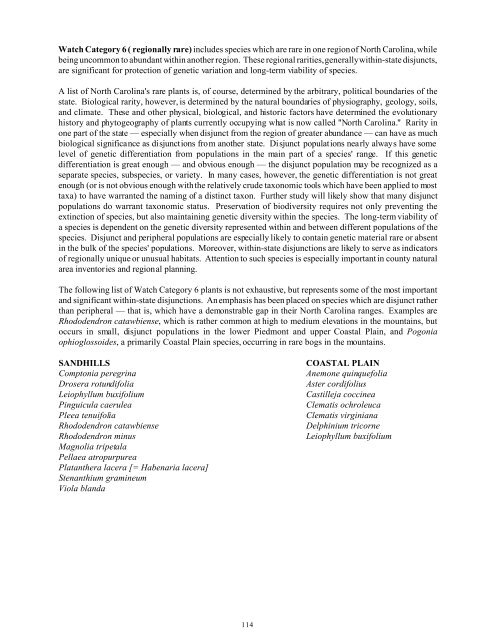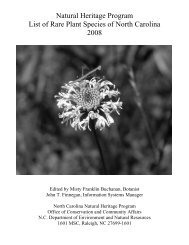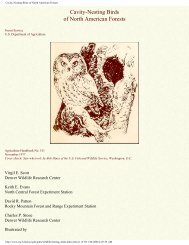Natural Heritage Program List of Rare Plant Species - Rawlings ...
Natural Heritage Program List of Rare Plant Species - Rawlings ...
Natural Heritage Program List of Rare Plant Species - Rawlings ...
You also want an ePaper? Increase the reach of your titles
YUMPU automatically turns print PDFs into web optimized ePapers that Google loves.
Watch Category 6 ( regionally rare) includes species which are rare in one region <strong>of</strong> North Carolina, while<br />
being uncommon to abundant within another region. These regional rarities, generally within-state disjuncts,<br />
are significant for protection <strong>of</strong> genetic variation and long-term viability <strong>of</strong> species.<br />
A list <strong>of</strong> North Carolina's rare plants is, <strong>of</strong> course, determined by the arbitrary, political boundaries <strong>of</strong> the<br />
state. Biological rarity, however, is determined by the natural boundaries <strong>of</strong> physiography, geology, soils,<br />
and climate. These and other physical, biological, and historic factors have determined the evolutionary<br />
history and phytogeography <strong>of</strong> plants currently occupying what is now called "North Carolina." Rarity in<br />
one part <strong>of</strong> the state — especially when disjunct from the region <strong>of</strong> greater abundance — can have as much<br />
biological significance as disjunctions from another state. Disjunct populations nearly always have some<br />
level <strong>of</strong> genetic differentiation from populations in the main part <strong>of</strong> a species' range. If this genetic<br />
differentiation is great enough — and obvious enough — the disjunct population may be recognized as a<br />
separate species, subspecies, or variety. In many cases, however, the genetic differentiation is not great<br />
enough (or is not obvious enough with the relatively crude taxonomic tools which have been applied to most<br />
taxa) to have warranted the naming <strong>of</strong> a distinct taxon. Further study will likely show that many disjunct<br />
populations do warrant taxonomic status. Preservation <strong>of</strong> biodiversity requires not only preventing the<br />
extinction <strong>of</strong> species, but also maintaining genetic diversity within the species. The long-term viability <strong>of</strong><br />
a species is dependent on the genetic diversity represented within and between different populations <strong>of</strong> the<br />
species. Disjunct and peripheral populations are especially likely to contain genetic material rare or absent<br />
in the bulk <strong>of</strong> the species' populations. Moreover, within-state disjunctions are likely to serve as indicators<br />
<strong>of</strong> regionally unique or unusual habitats. Attention to such species is especially important in county natural<br />
area inventories and regional planning.<br />
The following list <strong>of</strong> Watch Category 6 plants is not exhaustive, but represents some <strong>of</strong> the most important<br />
and significant within-state disjunctions. An emphasis has been placed on species which are disjunct rather<br />
than peripheral — that is, which have a demonstrable gap in their North Carolina ranges. Examples are<br />
Rhododendron catawbiense, which is rather common at high to medium elevations in the mountains, but<br />
occurs in small, disjunct populations in the lower Piedmont and upper Coastal Plain, and Pogonia<br />
ophioglossoides, a primarily Coastal Plain species, occurring in rare bogs in the mountains.<br />
SANDHILLS COASTAL PLAIN<br />
Comptonia peregrina Anemone quinquefolia<br />
Drosera rotundifolia Aster cordifolius<br />
Leiophyllum buxifolium Castilleja coccinea<br />
Pinguicula caerulea Clematis ochroleuca<br />
Pleea tenuifolia Clematis virginiana<br />
Rhododendron catawbiense Delphinium tricorne<br />
Rhododendron minus Leiophyllum buxifolium<br />
Magnolia tripetala<br />
Pellaea atropurpurea<br />
Platanthera lacera [= Habenaria lacera]<br />
Stenanthium gramineum<br />
Viola blanda<br />
114




